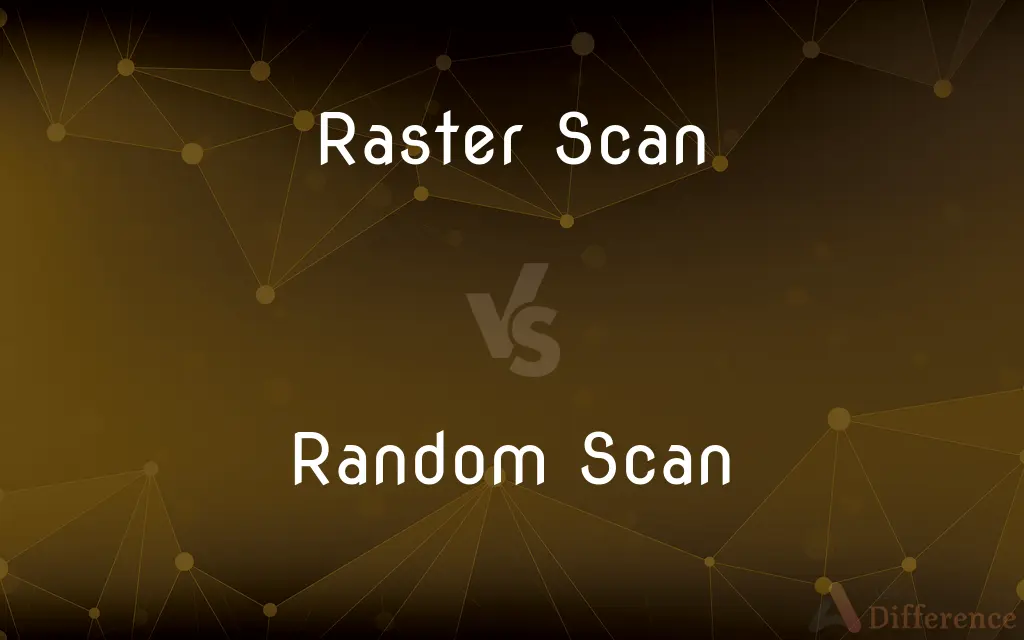Raster Scan vs. Random Scan — What's the Difference?
By Tayyaba Rehman & Urooj Arif — Published on February 2, 2024
Raster Scan displays images by scanning pixels in a horizontal line from top to bottom, whereas Random Scan draws images by directly drawing lines between specific points.

Difference Between Raster Scan and Random Scan
Table of Contents
ADVERTISEMENT
Key Differences
Raster Scan technology works by systematically drawing horizontal lines across the screen, updating pixels row by row. In contrast, Random Scan, also known as vector scan, selectively draws lines directly between specific coordinates, allowing for precise image rendering.
In Raster Scan displays, the entire screen is refreshed in a set pattern, even if there are no changes in the image. On the other hand, Random Scan updates only the parts of the screen where changes have occurred, making it more efficient for certain types of graphics.
The Raster Scan method is commonly used in standard television and computer monitors, as it is well-suited for detailed and complex images. Conversely, Random Scan is often used in applications like air traffic control and CAD systems, where dynamic line drawings are required.
Raster Scan displays can suffer from aliasing effects due to the pixel grid structure, but they excel in displaying color and detailed images. Random Scan systems, while less prone to aliasing, are limited in their ability to display complex shading and color gradients.
Raster Scan systems are typically more affordable and widely used in consumer electronics, while Random Scan setups are more specialized, catering to professional and industrial applications where precision line drawing is crucial.
ADVERTISEMENT
Comparison Chart
Image Generation
Scans lines horizontally across the screen
Draws directly between coordinates
Refresh Method
Refreshes the entire screen uniformly
Refreshes only the changed parts of the screen
Common Usage
TVs, computer monitors
CAD, air traffic control systems
Image Quality
Better for color and detail
Better for precise line drawings
Cost and Accessibility
Generally more affordable and common
More specialized and less widespread
Compare with Definitions
Raster Scan
Raster Scan is a method of displaying images by illuminating screen pixels along horizontal lines.
The raster scan method is evident in the resolution and clarity of digital photographs on screens.
Random Scan
Random Scan is a vector display method for rendering images by drawing lines between coordinates.
The air traffic control system's random scan display provided clear vector graphics.
Raster Scan
Raster Scan refers to the process of updating display pixels in a predetermined horizontal line pattern.
The computer monitor's clear image is a result of its raster scan system.
Random Scan
Random Scan involves directly drawing images on a screen by addressing individual vectors.
Random scan is preferred in certain scientific visualizations for its accuracy.
Raster Scan
Raster Scan involves scanning each line of pixels on a display screen in sequence from top to bottom.
The graphic artist preferred a raster scan display for its color accuracy.
Random Scan
Random Scan refers to the selective updating of screen areas based on image changes.
Engineers use random scan displays for designing complex mechanical parts.
Raster Scan
Raster Scan is a display method where an image is created by sequential horizontal line scanning.
Most modern televisions use raster scan technology to display images.
Random Scan
Random Scan is a method for creating images by directly manipulating lines rather than pixels.
CAD software often utilizes random scan for its ability to render precise line drawings.
Raster Scan
Raster Scan is a technique for rendering images by moving an electron beam across the screen in a line-by-line manner.
The raster scan in CRT monitors contributes to the screen's flickering effect.
Random Scan
Random Scan is a display technique where images are drawn by connecting specific points directly.
The Random Scan technology in the simulator allowed for precise aircraft trajectories.
Common Curiosities
What is Raster Scan?
Raster Scan is a display method that updates images by scanning pixels in horizontal lines from top to bottom.
What are the advantages of Random Scan?
Random Scan is efficient for dynamic line drawings and precise image rendering, making it suitable for CAD and air traffic control.
Can Raster Scan display detailed images?
Yes, Raster Scan is well-suited for detailed and color-rich images.
How does Random Scan differ from Raster Scan?
Random Scan draws images by directly connecting specific points, unlike Raster Scan, which updates entire lines of pixels.
Is Random Scan good for color graphics?
Random Scan is limited in displaying complex color gradients and is better suited for line drawings.
Do Raster Scan displays have a flickering effect?
Yes, especially in CRT monitors, due to the line-by-line scanning process.
Where is Raster Scan commonly used?
Raster Scan is commonly used in televisions and computer monitors.
What causes aliasing in Raster Scan displays?
Aliasing in Raster Scan displays is due to the pixel grid structure.
Are Random Scan systems expensive?
Random Scan systems are generally more specialized and less common, which can make them more expensive.
Does Random Scan refresh the entire screen?
No, Random Scan refreshes only the parts of the screen where changes occur.
Can Random Scan handle complex shading?
Random Scan is less capable of handling complex shading and is better for precise line drawings.
What is the main drawback of Raster Scan displays?
The main drawback is the inability to update only selected parts of the screen, which can be less efficient.
Are there specific industries where Random Scan is preferred?
Yes, industries like CAD design and air traffic control often prefer Random Scan for its precision and efficiency in line drawing.
Is Random Scan used in consumer electronics?
Random Scan is less common in consumer electronics and more prevalent in professional and industrial applications.
Which scan type is more suitable for graphic design?
Raster Scan is generally more suitable for graphic design due to its color and detail rendering capabilities.
Share Your Discovery

Previous Comparison
Opera vs. Musical
Next Comparison
Northern Ireland vs. Republic of IrelandAuthor Spotlight
Written by
Tayyaba RehmanTayyaba Rehman is a distinguished writer, currently serving as a primary contributor to askdifference.com. As a researcher in semantics and etymology, Tayyaba's passion for the complexity of languages and their distinctions has found a perfect home on the platform. Tayyaba delves into the intricacies of language, distinguishing between commonly confused words and phrases, thereby providing clarity for readers worldwide.
Co-written by
Urooj ArifUrooj is a skilled content writer at Ask Difference, known for her exceptional ability to simplify complex topics into engaging and informative content. With a passion for research and a flair for clear, concise writing, she consistently delivers articles that resonate with our diverse audience.
















































